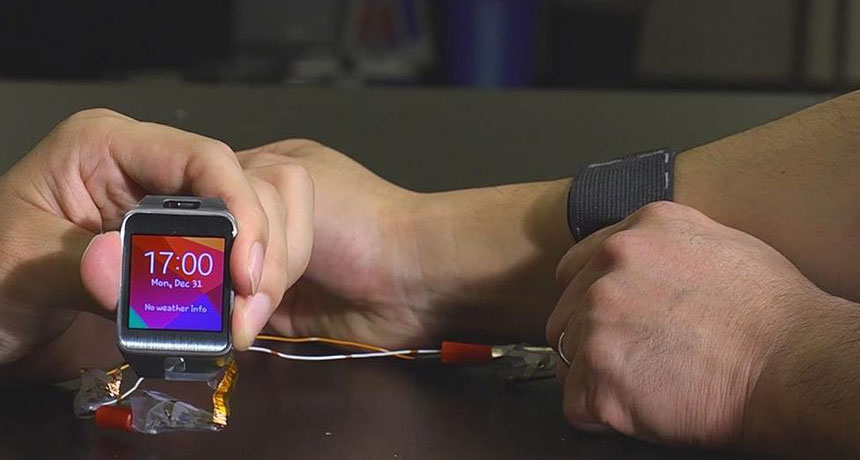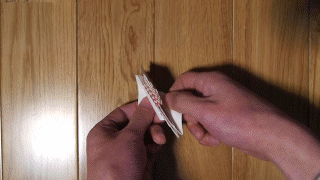This battery stretches without losing oomph
Japanese paper craft inspired engineers to create a flexible power source

A stretchable battery has been sewn inside an elastic strap worn on the arm, at right. The battery can power a smart watch.
Arizona State University/Nature
It’s no stretch to say that batteries won’t continue to be rigid and blocky forever. Engineers inspired by Japanese paper craft have designed a battery that can expand to 150 percent of its original length. The battery can power a computerized watch known as a smart watch even as it flexes.
“Any kind of portable or wearable system would benefit” from such a stretchable battery, says John Rogers. Rogers is a materials scientist at the University of Illinois at Urbana-Champaign. He did not work on the new battery, but a former colleague did.
Engineers are working to create electronic devices that move, adapt and even flex with their users. For example, a device stitched into an armband might play music during a workout. Or a sports jersey might track your heart rate, temperature and even location. To make that happen, engineers have to make devices that are small, durable and flexible. Those devices need compact sources of power with similar qualities.

The artist showed Jiang an origami pattern called the Miura fold. A piece of paper isn’t stretchy. However, a paper that incorporates a Miura fold can appear to stretch as it is folded and unfolded. The pattern “was very similar to one pattern we used when I was working with John Rogers,” says Jiang. “It had similar zigzag shapes. Then I thought, ‘Maybe we can use origami’” for batteries.
In January 2014, Jiang and his team introduced their first origami-inspired battery. Still, Jiang wasn’t satisfied. The battery didn’t stay two-dimensional and flat when flexed. Instead, the battery expanded outward into the third dimension too. Jiang wanted to build a battery that stayed flat even as it stretched. That’s because there isn’t much space to spare inside small electronic devices.
BEND AND STRETCH Learn more about the stretchable battery in this short video from Arizona State University NPG Press |
Then, Jiang found new inspiration in kirigami. This is a type of origami. Kirigami involves cutting as well as folding. He and his team used three different kirigami patterns as models for their batteries. When they finished, they produced batteries that stretched without losing power. Best of all, the batteries “could stretch without changing height,” says Jiang.
To test the battery, the experts sewed it into an elastic armband. The team then hooked up the battery to a smart watch. As they stretched the armband, the battery stretched with it. But the watch remained powered. They stretched the armband thousands of times. Even so, the battery barely lost any charge. The team published details of the new battery on June 11 in Scientific Reports.
Jiang and his team are now fine-tuning the battery to be small and durable enough for everyday devices. Still, “my team is working on a real watch strap that integrates the battery,” he says. In the future, flexible batteries could power devices built into everything from clothes to tiny space satellites, Rogers says.
Jiang is excited by the prospect of creating more electronics inspired by origami and kirigami. These Japanese forms of paper craft combine art and math. And that combination is powering scientists to think of geometry and space in new ways.
Power Words
(for more about Power Words, click here)
battery A device that can convert chemical energy into electrical energy.
electric charge The physical property responsible for electric force; it can be negative or positive.
electronics Devices that are powered by electricity but whose properties are controlled by the semiconductors or other circuitry that channel or gate the movement of electric charges.
engineer A person who uses science to solve problems. As a verb, to engineer means to design a device, material or process that will solve some problem or unmet need.
engineering The field of research that uses math and science to solve practical problems.
fabric Any flexible material that is woven, knitted or can be fused into a sheet by heat.
geometry The mathematical study of shapes, especially points, lines, planes, curves and surfaces
materials science The study of how the atomic and molecular structure of a material is related to its overall properties. Materials scientists can design new materials or analyze existing ones. Their analyses of a material’s overall properties (such as density, strength and melting point) can help engineers and other researchers select materials that best suited to a new application.
origami The traditional Japanese art of paper folding to create decorative figures and shapes.
satellite A moon orbiting a planet or a vehicle or other manufactured object that orbits some celestial body in space.







